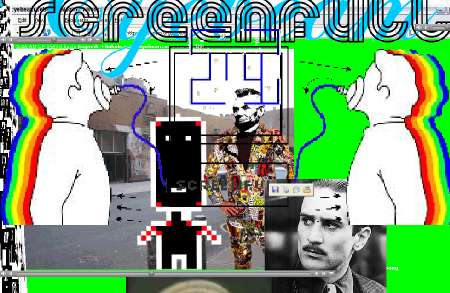cyber.tender.loving irony
June 29th, 2005Jimpunk, Paris: AcidMissile
——————————————————————————–
cyber.tender.loving irony
by ibro fooman hasanovic, Sarajevo
AcidMissile by the French artist jimpunk stands out from the other works shown by the project 56kTV. What compelled me to write about this piece is its ‘clean’ approach and the way the artist compiles the elements of his visual language.
The artist describes his work as “a motion painting including sounds,
java scripts, pop ups etc. …as an Internet movie”.
The use of sound, rhythm, movement and colours etc. leads us to the conclusion that there is a strong semiotic side to this work, which though “non-representational†is still important for interpretation.
Symbolic elements used in the work are commercial banners, Google searches, spam, ASCII graphics, chat dialogues, error sounds, electronic music and so on. This assemblage has a very strong visual impact, while the scenario of “action” and its dramatisation make the work dynamic.
It seems to me, that the artist has succeeded in creating a perfect balance between semiotic and symbolic elements, which Julia Kristeva considers as the basis of representation.
Regarding the message (meaning) of this work, the artist perhaps dedicated quite some time to establish a visual effect, which I think is not a minus point at all.
Consumer Society is a society which consumes signs and becomes saturated with the aestheticized images of “Advertising” (in this case with the symbolic elements used in the work).
“This society is no longer based on production, but on representation and seduction” said Jean Baudrillard after all.
The “Aggression†and even more so the irony present in this work and in its concept can be read as an articulation of the “horror†in capitalistic contemporary life.
“There is no document of civilization that is not at the same time a document of barbarism” said Walter Benjamin.
There is something quite barbaric about jimpunk’s AcidMissile, which we can connect with our daily experiences. The use of pop-ups reminds us of jumbo posters, the typography and the titles remind us of the neon light signs/commercials and the performative character of this work reminds us of the worst nightmares happening to us sometimes while surfing the net – especially if one has had the experience of how annoying pop-up’s can be (and if you are like me, you wish, they had never been invented).
I do not know how effectively AcidMissile can light a little bulb in our head exposing the daily dose we get of this nightmare, a nightmare that implants itself spontaneously but very effectively into our consciousness or even into our sub consciousness.
I feel that when you see AcidMissile for the first time it is like driving through Las Vegas.
You are under a big impression of its “greatnessâ€. You don’t really read the neon signs, LED commercials, screens and all its Postmodernist paraphernalia; it’s much too fast. You just relax and enjoy the cruise, but subconsciously the information seeps into your brain. Unfortunately, after a couple of minutes, you are very confused, you don’t know where you are, where you want to go and where you are going. It is dangerous, but then, again, it’s cool.
Maybe this is the best metaphor for AcidMissile, because I think “space†on the internet feels just like that, when you travel through and experience it. I always imagine the net as big highways and roads of information.
jimpunk has created here a well balanced, clean and direct “bombâ€, that puts forward the question of another kind of terrorist threat – not from those terrorists wanting to fulfil their political or religious ideologies, but from terrorists hiding within the capitalistic system, who want to reach their economic goals. These are the terrorists hiding in ourselves, manifested through the information we release on the internet about our own “humble†mortal lives.
And this kind of terrorist threat, our personal one, is perhaps the most dangerous, because we can resist other forms of terrorism maybe, but can we possibly resist our own personal terrorism?
If all creativity is a result of revolt, this work maybe is jimpunk’s revolt. But does it create the need for any kind of a revolt within you?
Another way to conclude this text about the meaning of jimpunk’s work could be as follows:
It’s title – AcidMissile – is composed of
“acid†(: a slang for LSD; bitter sharp taste; critical and unkind, sarcastic…) and of
“missileâ€: object or weapon that is thrown or fired at a target, explosive weapon directed at a target automatically or by means of an electronic device (guided missile).
By combining these two words you get the title for cool, sharp and great art.
——————————————————————————–
ibro fooman hasanovic, Sarajevo.
Born in 1981. Works in the field of video, photogrpahy, drawing and film. His works are generaly comments on identity and history of art. Curently studies at Fine Arts Academy in Sarajevo. Cooks food, drinks votka and from time to time writes.
Jimpunk, Paris
Recent works and participations: 18th Stuttgarter Filmwinter, January 13 16,2005; CYNETart_04areale :: 2003-0153 1n-0ut [meditation]; The Infinite Fill Show, Foxy Production NYC; Festival Ciberart-Bilbao 2004; Simple Net Art Remix (); p0es1s. Digitale Poesie / Digital Poetry Berlin; postartum, long beach, california; tirana biennale 2 new media, (cv see: https://www.jimpunk.com/info/news00.html#festival)
originaly from 56kTV
 pubblicato mercoledì 11 maggio 2005
pubblicato mercoledì 11 maggio 2005
